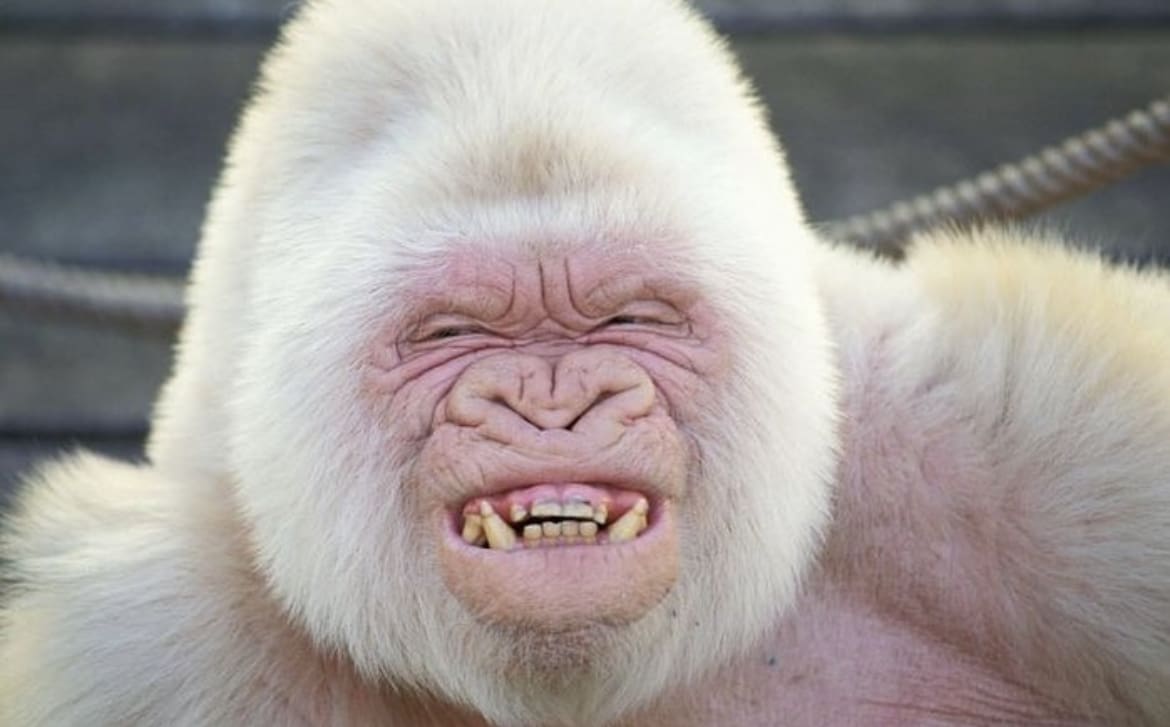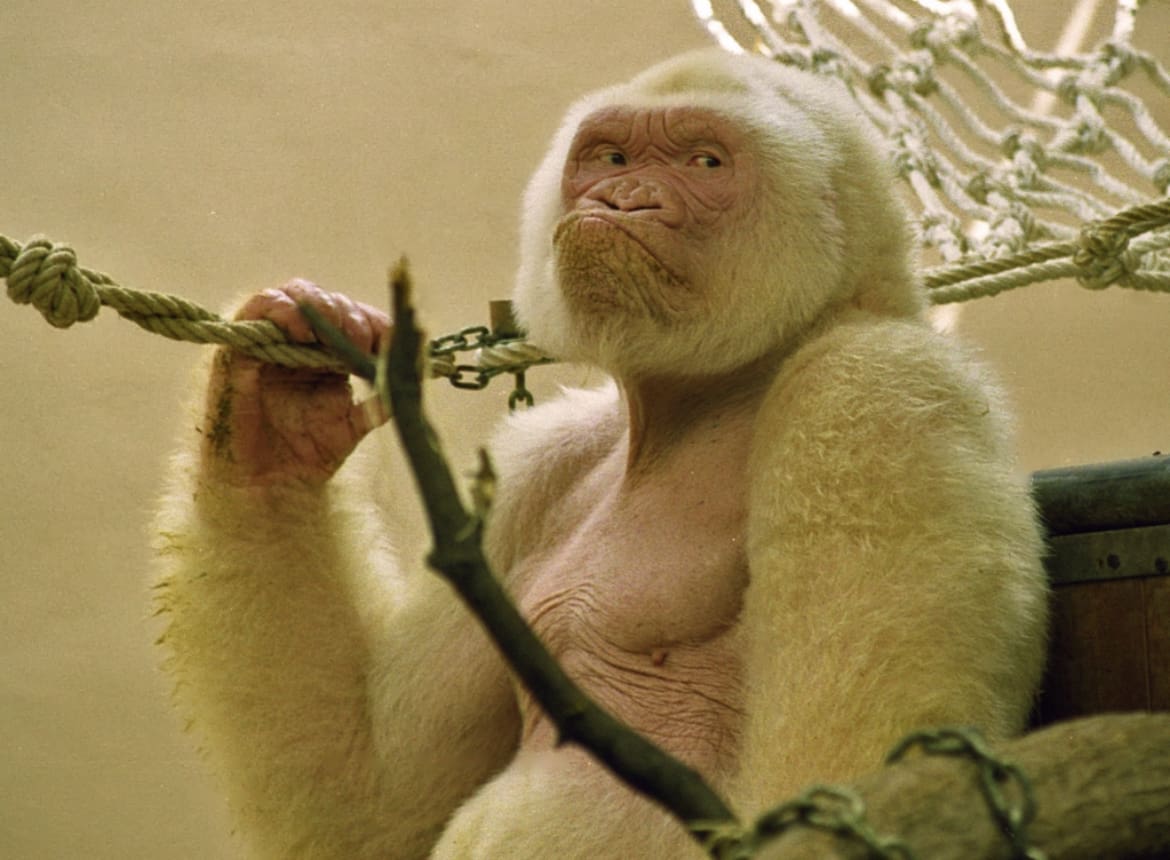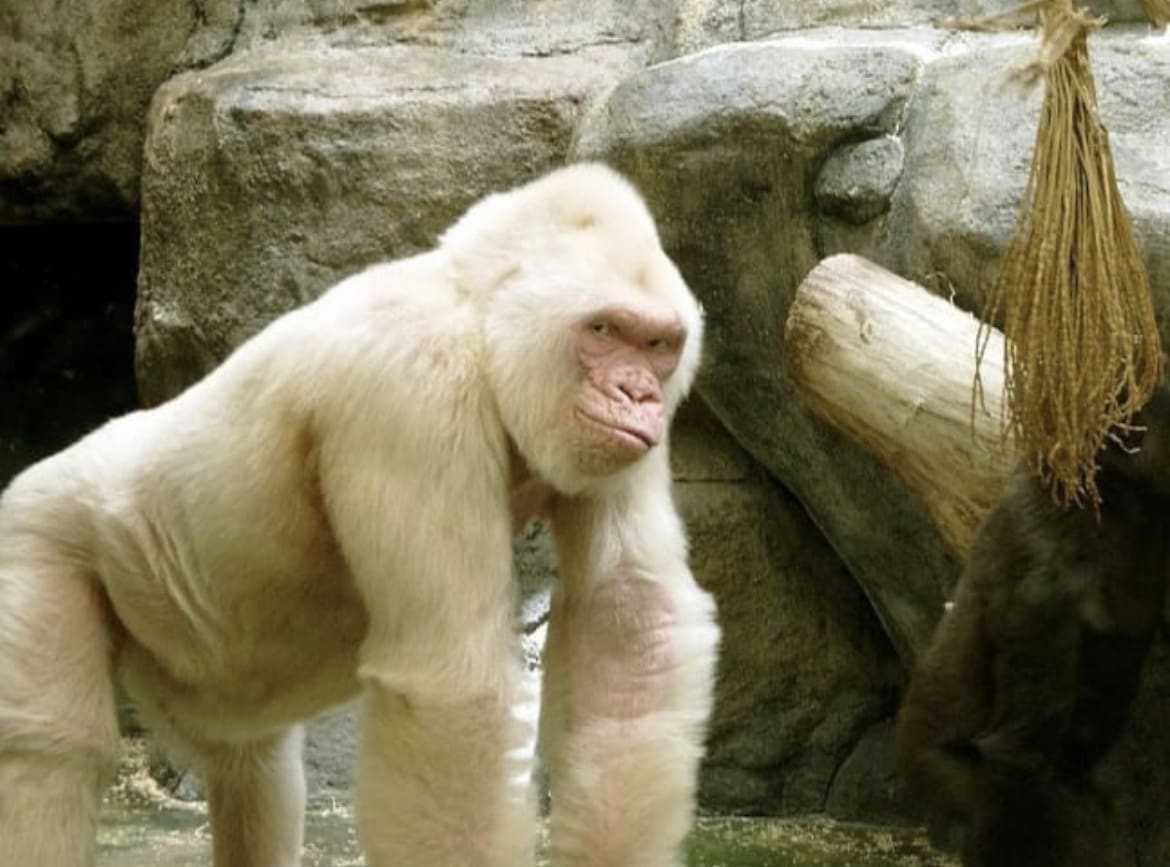Ever stumbled upon a story so unique it sticks with you forever? Let me introduce you to Snowflake – no, not those icy crystals that hit your face during winter but an albino gorilla whose story is just as cool.
The Legend of Snowflake the White Gorilla
Snowflake was not your average gorilla; this dude was white due to albinism, making him a real-life legend at the Barcelona Zoo. His story isn’t just a tale of uniqueness; it’s a powerful narrative that bridges the gap between humans and wildlife, urging us to pay attention to the world beyond our cityscapes.
Snowflake’s Origin: Unveiling the Mystery
Imagine wandering through the dense, humid forests of Equatorial Guinea in the ’60s, only to spot a snow-white baby gorilla amidst the greenery. That’s exactly how Snowflake’s adventure began. Discovered by local farmers, Snowflake was immediately set apart from his peers, not just by his color but by the curiosity he sparked among humans. His journey from the wild to becoming Barcelona Zoo’s most iconic resident is nothing short of a blockbuster movie plot.
But let’s dig a bit deeper here. Albino animals in the wild are like finding a needle in a haystack. For Snowflake, this rarity came with a genetic twist – a mutation that made him the only known albino gorilla to have ever existed. This wasn’t just about a change in color; it was a phenomenon that challenged our understanding of wildlife genetics and conservation.
Snowflake’s story is more than just an anecdote for zoo visitors; it’s a wake-up call to the realities faced by animals around the globe. His albinism, while making him a star, also exposed him to risks – from health issues due to sun exposure to being an easy target in the wild. Yet, Snowflake thrived under the care of Barcelona Zoo, becoming a symbol of survival against the odds.

The Science Behind the Snow: Understanding Albinism in Animals
Alright, folks, let’s geek out for a bit. Albinism isn’t just about sporting a unique look; it’s a genetic curveball that throws the body’s melanin production off track. In Snowflake’s case, this meant his skin and fur were as white as the driven snow, a stark contrast to the typical black coat of his fellow gorillas.
But here’s where it gets interesting – albinism affects more than just appearance. It comes with a suitcase of health challenges, like sensitivity to sunlight and vision problems. Imagine trying to navigate the complexities of gorilla society without the standard camouflage or sharp eyesight. Snowflake’s life was a testament to resilience, showcasing how animals with unique conditions can thrive with a little help from their human friends.

A Glimpse into Snowflake’s Daily Life
Curious about what a day in the life of Snowflake looked like? Picture this: a spacious enclosure designed to mimic the lush forests of Africa, complete with ropes, trees, and plenty of room for somersaults. Snowflake wasn’t just lounging around; he was living his best life, thanks to the dedicated zookeepers at Barcelona Zoo. Their commitment to his wellbeing was unmatched, ensuring he had the right diet (vitamin supplements included), protection from the sun, and, of course, plenty of enriching activities to keep his mind sharp.
But Snowflake’s habitat was more than just a home; it was a classroom. Through him, visitors and scientists alike delved into the fascinating world of gorilla behavior, conservation, and the importance of genetic diversity. His presence at the zoo wasn’t merely for spectacle; it was an ongoing lesson in empathy and environmental stewardship, encouraging us to look beyond the concrete jungles and consider the lives of our distant relatives in the wild.
Snowflake’s daily life was a blend of care, education, and advocacy. It’s a narrative that goes beyond feeding times and enrichment activities, touching on the zoo’s broader mission to foster a connection between humans and animals. Through Snowflake’s eyes, we’re given a glimpse into the complex, intriguing world of wildlife conservation, reminding us of the delicate balance that sustains life on our planet.

Snowflake’s Legacy: Beyond the Enclosure
Now, let’s zoom out a bit and look at the bigger picture Snowflake painted for us. His snowy fur wasn’t just a marvel to behold; it was a canvas that sketched the broader strokes of wildlife conservation. Snowflake’s legacy isn’t merely about remembering an albino gorilla; it’s about recognizing the profound impact one unique individual can have on global awareness and scientific curiosity.
Snowflake became a beacon for endangered species, shedding light on the threats facing gorillas and countless other animals. His story catalyzed conversations about habitat destruction, poaching, and the effects of climate change. It’s as if Snowflake whispered to us, urging humanity to wake up and take action before it’s too late. Beyond the enclosure, he symbolized the interconnectedness of all living beings and the urgency of our conservation efforts.
Furthermore, Snowflake’s genetic makeup became a subject of fascination for researchers. His existence prompted studies on genetic mutations and their implications for animal populations. Scientists delved into the DNA of this remarkable gorilla, seeking insights into albinism and its survival implications in the wild. Through research inspired by Snowflake, we gained a deeper understanding of biodiversity and the critical need to preserve genetic variation within species.

The Impact of Snowflake: Conservation and Awareness
Snowflake did more than just exist; he inspired a movement. The ripple effect of his story reached corners of the globe, stirring a collective consciousness about our planet’s fragile biodiversity. His life underscored the importance of zoo conservation efforts, not just as sanctuaries for unique animals like him but as hubs of education and scientific research.
The awareness Snowflake generated has fueled conservation initiatives worldwide, from anti-poaching campaigns to habitat restoration projects. His legacy is a testament to the power of individual stories in mobilizing efforts to protect our natural world. By bringing attention to the plight of endangered species, Snowflake’s story encourages us to support wildlife preservation in any way we can, be it through adopting sustainable practices, supporting conservation organizations, or simply spreading the word.
Moreover, Snowflake’s influence extends to the realm of educational programs. Zoos and conservation centers have leveraged his story to engage the public, particularly the younger generation, in meaningful dialogues about environmental stewardship. Through interactive exhibits and educational campaigns, Snowflake’s life serves as a compelling narrative that fosters a deeper appreciation for the richness of our planet’s biodiversity and the critical role humans play in its preservation.
In essence, Snowflake’s impact is a mosaic of conservation, awareness, and scientific inquiry. His legacy is not just about remembering a white gorilla but about embracing the responsibility we share in safeguarding the natural world for future generations. As we continue to navigate the challenges of conservation, Snowflake’s story remains a beacon of hope and a reminder of the beauty and diversity that exist in the wild, urging us to act before it’s too late.
Wildlife Preservation: How You Can Contribute
As we’ve journeyed through Snowflake’s life and legacy, it’s clear his story is more than a tale of an albino gorilla—it’s a clarion call for conservation action. But how do we, especially the urban dwellers, the millennials glued to screens, step up for wildlife preservation? Snowflake’s legacy offers us a roadmap.
First off, understand that every action counts. Start small: recycle and reduce waste to lessen your environmental footprint. These efforts contribute to broader conservation goals by reducing habitat destruction and pollution. Next, support wildlife conservation organizations financially or through volunteer work. Many of these groups work tirelessly to protect endangered species and habitats, and they rely on our support to continue their crucial work.
Travel responsibly. When you’re planning your next adventure, consider eco-tourism options that support conservation efforts and local communities. Visiting animal sanctuaries and eco-friendly zoos, like the Barcelona Zoo, can be both enlightening and a way to contribute financially to conservation projects.
Educate yourself and others. Knowledge is power, and in the digital age, spreading awareness about wildlife conservation has never been easier. Share stories like Snowflake’s on social media, discuss environmental issues with friends, and stay informed about the latest conservation news and how you can help.
Finally, advocate for policy changes. Support legislation that protects endangered species and habitats. Voice your concerns and advocate for change. Whether it’s signing a petition, attending a rally, or writing to your representatives, every action contributes to a larger movement towards preserving our planet’s biodiversity.
Conclusion: Remembering Snowflake, Embracing Diversity
As we wrap up our journey through Snowflake’s extraordinary life, let’s not see it as an end but a beginning. A beginning of a deeper understanding, commitment, and action towards preserving the wondrous diversity of our planet. Snowflake was more than a marvel of nature; he was a message, a story of resilience, beauty, and the urgent need for conservation.
His legacy is a reminder of the fragile beauty that exists in the corners of our world, often hidden but immensely valuable. It challenges us to look beyond our immediate surroundings and consider the broader tapestry of life that sustains us. Snowflake’s story is a call to action, an invitation to embrace the diversity of life and to work tirelessly to protect it.
As we move forward, let Snowflake’s memory inspire us to make conscious choices that support our planet’s health and diversity. Let’s be the voice for those who cannot speak, the protectors of the unseen and unheard. Our actions, no matter how small, can contribute to a legacy of conservation that honors Snowflake and the countless other species that enrich our world.
In remembering Snowflake, let us commit to a future where the beauty and diversity of all life are cherished, protected, and celebrated. It’s a journey worth taking, a story worth telling, and a legacy worth building. Together, inspired by the white gorilla’s legacy, we can make a difference in the world of wildlife conservation. Let’s start today.


